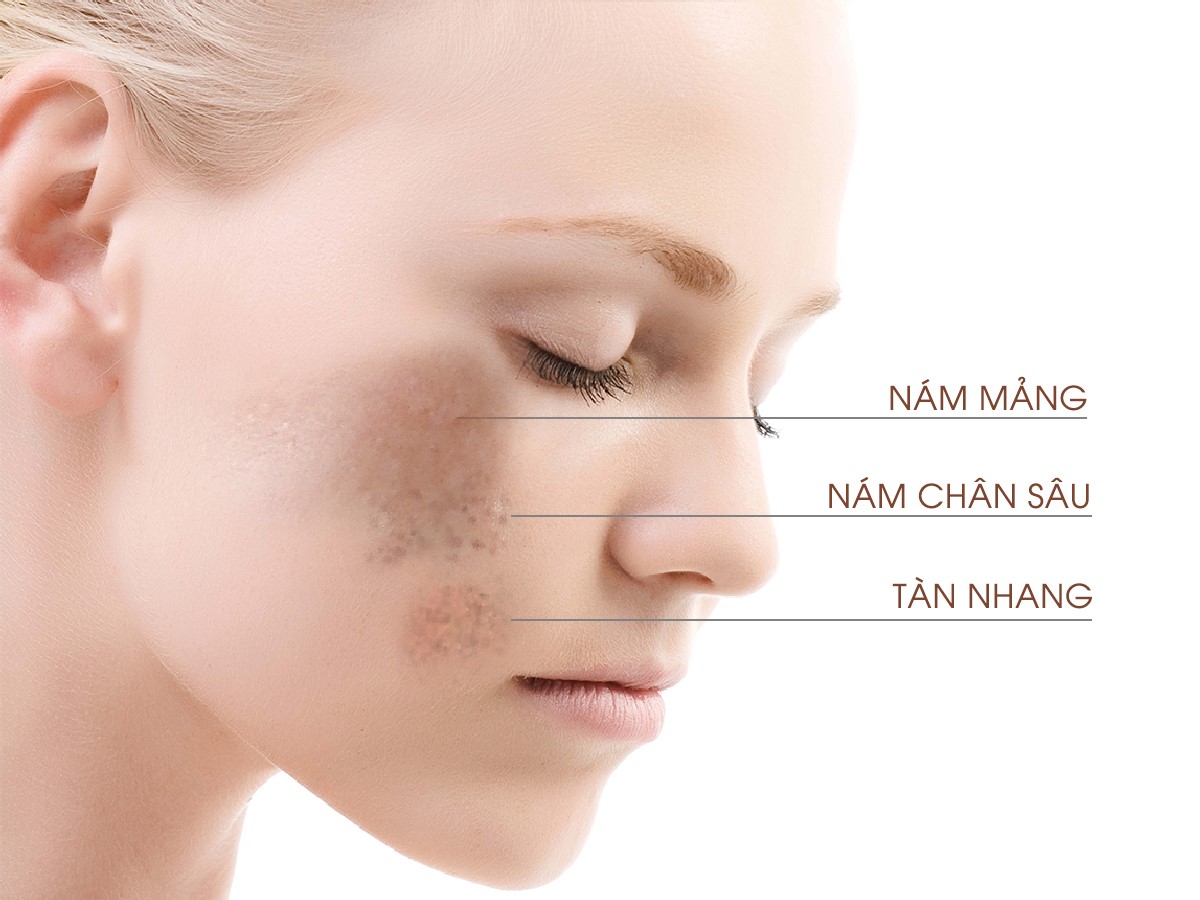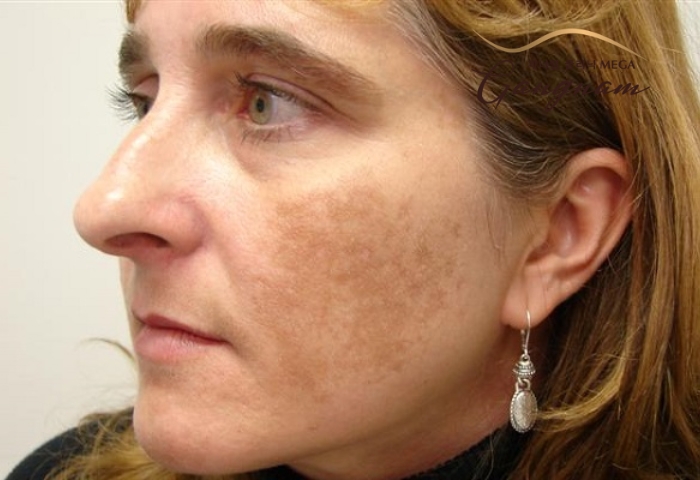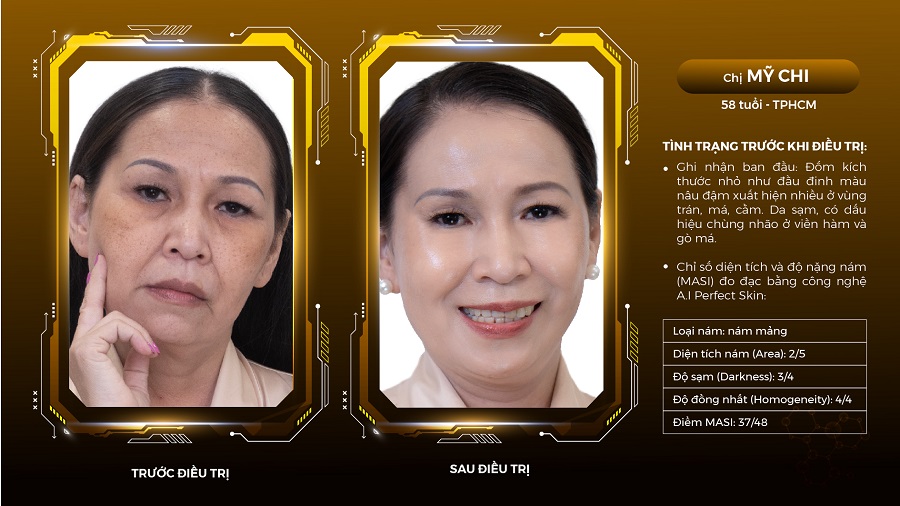What is Melasma? Is Treating Melasma Difficult?
Statistics on skin conditions in addition to the skin show that over 80% of Vietnamese women in adulthood are facing the phenomenon of melasma. Among them, the highest percentage is the condition of melasma. Although this is not a dangerous dermatological condition, the impact on appearance is undeniable. For those who do not know what melasma is and how to treat it, here is some very useful information referenced by dermatologists from Mega Gangnam, South Korea!

What is Melasma? Is Treating This Type of Pigmentation Difficult?

Identifying Melasma through Color, Shape, and Size
The most common type of melasma appears on the cheeks, forehead, and chin, which are areas with the thinnest and most delicate skin texture. Depending on individual factors and triggering causes, melasma may occur in a small area or across the entire facial region. Due to its concentration in the epidermal layer, if treated appropriately, this patchy type of melasma is much easier to eliminate compared to spot-like pigmentation. The characteristic signs of identifying melasma patches are as follows:
- In shape: Melasma patches do not have a fixed shape but often form large, nearly round patches. The size of the pigmentation is approximately 2-4 cm and has the potential to expand if early intervention methods are not applied.
- In location: Melasma patches can form on any part of the skin, but they are most common in areas with thin and delicate skin, such as the cheeks, forehead, and chin.
- In color: The color spectrum varies from light to dark brown, revolving around brown tones. The more severe the melasma, the more noticeable the color variations become, making it easier to recognize.
What are the causes of melasma on the face?
Whether the treatment of melasma patches achieves the desired results depends largely on the direct causes leading to the appearance of pigmentation on the face. Most people are unaware of why, despite careful care, protection, and shielding, melasma can still develop. The following information will help you identify why your face has melasma and why, despite following a skincare routine, some people don’t experience melasma while others do.

Causes of Melasma Development on the Face
Direct Causes Affecting Melanin Synthesis Leading to Melasma Patches:
- Hormonal Changes: During specific periods or under the influence of internal factors, hormones or endocrine disruptors may become imbalanced. This creates favorable conditions for prolonged melanin synthesis, leading to the formation of melasma and various other types of pigmentation.
- Sunlight Exposure: Undeniably, sunlight, along with harmful UV rays, is the most significant and direct cause of facial melasma. Furthermore, exposure to sunlight during unfavorable times (from 9 a.m. onwards) can contribute to various facial skin conditions, posing a high risk of skin cancer.
- Side Effects of Medications: Certain medications, such as oral antibiotics, antidepressants, or birth control pills, can negatively impact endocrine balance and stimulate melanin synthesis.
- Functional Disorders: The existence of the liver in the body is crucial for purifying food and drinks ingested and expelling toxins. However, severe impairment of liver function can adversely affect the face, being the first area affected.
In addition to the direct causes mentioned above, several underlying factors contribute to the appearance of melasma on the face that you should be aware of:
- Genetic Factors: Inherited traits often influence physical appearance. If close family members have a history of melasma, there is a higher likelihood that you may develop it later.
- Use of Inappropriate Cosmetics: Using expired, low-quality, or incompatible skincare products can weaken the skin, making it more susceptible to allergies and irritations. As a result, harmful rays penetrate and damage the skin, accelerating pigmentation.
- Common Risk Factors: Poor diet, improper rest, work-related stress, and prolonged instability can lead to an imbalance, both physically and mentally, increasing the risk of facial melasma.
Frequently Asked Questions About Melasma

Melasma is Easier to Treat Compared to Freckles and Persistent Pigmentation
Is treating melasma challenging?
Melasma appears very prominently on the surface of the skin, covering a relatively large area with vibrant colors, significantly affecting one’s appearance. Therefore, many people consider this type of pigmentation to be dangerous and challenging to treat thoroughly. Moreover, melasma quickly weakens the skin, leading to manifestations such as wrinkles, fine lines, and sagging skin.
In reality, melasma can be viewed as the easiest type of pigmentation to treat on the skin compared to freckles or mixed pigmentation. This stems from the fact that melasma only forms in the epidermal layer of the skin, meaning it only affects the upper surface. If the treatment method is applied correctly, according to the guidelines, resolving melasma is only a matter of time.
However, due to individual differences and the body’s response to treatment, there may be cases where melasma cannot be completely eliminated. This can result in the reappearance of pigmentation at any time. Therefore, it is essential to choose a safe and effective treatment method that can quickly prevent pigmentation from returning. The applied method should meet critical requirements, providing internal treatment while reducing the appearance of pigmented areas externally. This way, melasma is less likely to return or develop negatively on the skin.
Do facial creams for treating pigmentation have any side effects?
Currently, there are several creams on the market containing high concentrations of hydroquinone used to treat pigmentation. This can cause skin irritation, photosensitivity reactions, and the risk of post-inflammatory hyperpigmentation. Especially, some color-reducing agents may lead to cancer, so you should be cautious with creams containing these ingredients. Ideally, use products with moderate concentrations and safe sources.
Is pigmentation related to cancer?
Pigmentation appearing on the face is not cancer. However, in some cases, the sudden appearance of pigmentation may be a sign of cancer. Since some manifestations of skin cancer can resemble pigmentation issues, it is advisable to consult a doctor for the most accurate diagnosis.
Treating pigmentation with which method?
The extent of pigmentation, the affected areas, and the duration of appearance largely determine how we should choose facial treatment. For those with mild pigmentation, where the color is relatively faint, it is advisable to start with external treatments. This is the first step to inhibit the formation and development of various pigmentation on the skin surface. In cases where pigmentation appears early, with a yellow-brown or dark brown color, it is necessary to combine internal therapy with advanced technology solutions for pigmentation reduction. Specifically, as follows:
Using Natural Ingredients
Utilizing readily available natural ingredients at home to treat newly formed facial pigmentation is extremely beneficial. This method of pigmentation treatment is safe, gentle, and very easy to implement. It’s also a way to optimize the effectiveness of treatment and save costs when you’re unsure where to start. The following plant-based ingredients will help fade pigmentation if used consistently and over the long term.

Treating Melasma at Home with Natural Ingredients
- Turmeric: Clean the fresh turmeric, then soak it in diluted saltwater and squeeze out the juice. Use a cotton pad to apply the turmeric water evenly to the pigmented areas on the face. Keep it on the face for about 20 minutes and then clean it with a facial cleanser solution. It’s recommended to use this mask at least 2-3 times a week and maintain it for 1-2 months to check the effectiveness.
- Eggplant: Use cleaned eggplants and slice them into thin pieces. Wash your face with a facial cleanser and balance your skin with toner for better nutrient absorption. Then, apply the thin slices of eggplant to the pigmented areas on your face. Similar to the previous method, leave the ingredients on your face for about 20 minutes and then wash it off with warm water. Follow up with your regular skincare routine.
- Fresh Lime: Limes contain a significant amount of vitamin C and essential enzymes that can help fade pigmentation and brighten the skin tone. For those with thick, oily, or acne-prone skin, you can use lime juice and apply it to your face for about 10 minutes before rinsing it off, balancing the pH, and moisturizing immediately. It’s advisable to maintain these steps 1-2 times a week.
In addition to the mentioned ingredients, you may also consider using other ingredients such as honey, basil, potatoes, tomatoes, etc., for facial masks to treat pigmentation.
Using Oral Medication and Topical Creams
For those dealing with severe pigmentation or seeking a medical-oriented treatment approach, oral medications and topical creams are safe and effective options. In cases where facial pigmentation has been persistent, influenced by environmental factors or hormonal imbalances, natural remedies may not be the recommended method. Consider using the following types of medications:
- Topical creams containing ingredients such as niacinamide, Vitamin C, azelaic acid, Hydroquinone, etc.: These active ingredients are beneficial for the skin and are used for various purposes, from reducing scar pigmentation to stimulating skin lightening and inhibiting melasma and pigmented spots. Depending on the severity of facial pigmentation, you may consider the concentration of these active ingredients.
- Oral medication or dietary supplements: When opting for oral medication or supplements, it’s advisable to seek safe, reputable products from manufacturers in Japan, the United States, France, etc. However, certain individuals may not be suitable for this treatment method, or their bodies may not absorb the substances effectively. Therefore, oral medication and dietary supplements should be viewed as supportive solutions and not the sole method of treatment.

Types of Topical Creams Effective for Melasma Treatment
Modern Technology-Based Melasma Treatment Methods
From an objective standpoint, treating melasma with the mentioned methods cannot entirely address the root causes of pigmentation and risk factors. Additionally, melasma can exacerbate if not properly controlled. Advanced technology-based methods are becoming increasingly popular and are recommended by experts due to their ability to quickly address melasma patches, deliver positive results, and prevent its recurrence after just a few sessions. Among the most notable technologies for treating melasma and restoring the skin is the Mega Fiber White method.
Experts highly advocate treating facial melasma with deep technologies such as Mega Fiber White. Compared to methods like nutrient injection, stem cell therapy, laser treatment, etc., Mega Fiber White technology possesses outstanding and entirely distinctive advantages, such as:
- Eliminating 100% of melasma types, including severe melasma, deep-rooted melasma, and melasma on damaged or aging skin.
- Achieving melasma treatment effectiveness six times higher than other current methods on the market. Moreover, the sustainability after melasma treatment is higher, with a lower risk of melasma recurrence.
- Ensuring absolute safety and suitability for various individuals in need of treatment. The most appropriate approach will be determined based on the skin condition and underlying health issues.
- Applying top-tier melasma-specific therapies and skin regeneration. An exemplary method is the exosome secretion therapy, providing 60 billion particles to enhance skin thickness and quality. This forms a permanent barrier preventing melasma infiltration and recurrence.

Before and After Treating Melasma with Mega Fiber White Technology
Although providing rapid results, once you’ve decided to treat melasma with advanced technological solutions, it’s crucial to select a reputable aesthetic center to entrust your confidence. Deep-treatment methods should be performed by highly qualified doctors with many years of experience and the most modern machinery. This is of utmost importance to ensure safety and achieve the best results post-treatment.
Mega Gangnam, positioned as one of the leading international aesthetic clinics and the exclusive provider of Mega Fiber White technology for super targeted treatment of melasma, deep-rooted pigmentation, etc., will undoubtedly offer you an excellent experience! Contact Mega Gangnam now via the Hotline: 093.770.6666 if you are dealing with melasma and haven’t found an effective solution yet!













